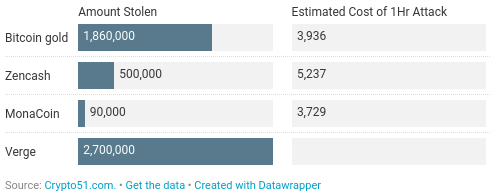Inside the Meteoric Rise of ICOs
Initial Coin Offerings ("ICOs") have quickly grown
to account for more startup funding in blockchain-based companies than all of Venture Capital. Nearly $2.3 billion has been raised to date in ICOs, with the large majority of that taking place in the first half of 2017. In 2015 there was a smaller market for ICOs, where a million dollar sale was a rarity. Only a few of the most visible projects were raising sums in the millions.
Then in 2016 the DAO raised over $150M in a few days, though it was later plagued with security issues and determined to be in violation of securities laws by the SEC. However, the size and speed of the funds raised for the DAO helped bring further attention to ICOs as a sale/funding model. Fast forward to 2017 and we’ve seen a meteoric rise in the amount of funding raised monthly in ICOs. April was $103M. May $232M. June hit $462M. July $574M.
How ICOs Work
Rather than looking to traditional angel or venture investors to place capital as an equity investment, companies developing new blockchain-based products and services have turned to the cryptocurrency community to crowdsource the purchase and usage of their token in an ICO. ICOs are similar in some ways to a crowdfunding campaign, but instead of offering a copy of a product like on Kickstarter, or shares of equity in a startup like on Crowdfunder, what is being offered are digital “tokens.” This process of selling new cryptocurrency tokens in an ICO results in funding received via cryptocurrency, most commonly in Bitcoin or Ether.
But there's more to it…
Utility Tokens
Most ICOs being done today aren't intended to be securities offerings, as they don't offer equity or ownership in the underlying company the way traditional angel or venture investments do. Rather, a large majority of ICOs are intended as “utility tokens" which allow buyers of the token to access and pay for usage of a blockchain-based software service.
One example of a utility token in use today is the Ether token, as it relates to the Ethereum computing platform. Ethereum is the blockchain-based platform where the large majority of the current ICO’s have been developed. When using the Ethereum network, there are costs associated with the processing of blockchain-based transactions. These costs are paid in the form of the tokens used on Ethereum, called Ether. These transaction fees paid in Ether are called "gas" in the Ethereum network. In this way, the Ether token provides access to, and payment for, the computing and transactional functions of Ethereum. But beyond its transactional usage, Ether is also a cryptocurrency that is bought, sold, and traded on the open markets.
And while some tokens may not be considered a securities offering (utility tokens), the recent SEC release put out in July warned investors about the potential for fraud with ICOs as unregulated sales. Specifically, the release outlined details of the SEC investigation into the DAO which raised over $150M in its own ICO, and reiterated its ongoing concerns that some ICOs may constitute securities offerings, like the DAO, while not being treated as such. No formal new rulings or restrictions on ICOs have been issued recently by the SEC, though China recently banned ICOs altogether.
Are Securities Tokens The New Equity Crowdfunding?
In contrast to utility tokens, some ICOs are already being done as registered securities offerings. One example is longtime Bitcoin and cryptocurrency investor and entrepreneur Brock Pierce, who sees a bright future in ICOs with registered securities – meaning they may include equity or some form of an investment return in connection with the tokens sold in the offering. Pierce is arguably a pioneer of the ICO space as an investor in Mastercoin, the first ICO, in 2013. More recently, his venture capital firm Blockchain Capital did the first ever ICO for a token as a security (BCAP token), selling participation in their venture capital fund as a liquid cryptocurrency.
As we saw with the JOBS Act and equity crowdfunding laws, broader regulation can help open up a new market while protecting investors with regulated processes. But regulations can also introduce overly-burdensome requirements that hamper innovation and capital formation, as has seemed to be the case with the weak adoption by startups of Title III of the JOBS Act.
What’s Driving the Growth of ICOs
With an understanding of what ICOs are, and an overview of how they work, there is still the question of what’s behind their incredible growth. Here are several of the likely contributors to the growth of this market, along with thoughts on each from leaders in the cryptocurrency and venture investing space…
1. The Massive increase in the Value of Cryptocurrencies
The market capitalization of all Cryptocurrency has risen from $7 billion in January of 2016 to over $130 billion as of now in September 2017. Bitcoin has appreciated nearly 30X since September of 2013 ($135 USD per Bitcoin), reaching over $4,000 per Bitcoin in September of 2017. In part, this is due to Bitcoin’s role as the most widely known, used, and accepted cryptocurrency for payments. Ether has appreciated more than 100X since August of 2015 ($2.83 USD), reaching over $300 in September of 2017. In part, this has been due to Ether’s role as the core utility token of Ethereum – the most widely used blockchain-based computing platform for ICO’s / token sales.
The early cryptocurrency buyers and holders have experienced massive gains and are now sitting on hundreds of millions, or even billions, in cryptocurrency value. ICOs are a way for some of these early cryptocurrency holders to diversify their holdings using the cryptocurrency itself, without taking their money out into fiat currency (offline bank-based dollars). Sam Englebardt, Managing Director of Private Investments at Galaxy Investment Partners, the family office of billionaire and large cryptocurrency investor Mike Novogratz, said…
“It would be naive not to acknowledge that there’s something very bubbly about what’s going on here with ICOs, but it’s also the easy answer. While bubbles are sometimes fueled by nothing more than pure speculative mania and greed, most are actually rooted in something very real. Railroads were that way. The internet was obviously like that; the excitement was built on a legitimately transformative innovation and, when the dust settled, that innovation ultimately met and exceeded the initial speculators’ wildest expectations.
I think the same is true with the blockchain — the underlying potential of the blockchain to touch and disrupt so many different aspects of our lives, on a global scale, is becoming apparent. Ideas spread fast these days and crowdfunding did a lot of the groundwork to make those ideas actionable. It can’t go up like this forever, but I’d say we have a long way to go before we hit the top."
2. The Power of Blockchain, Tokenization, and Decentralization
In the last year we’ve seen an incredible move by startups and founders towards use of blockchain technology and tokenized models. Rather than building new products on centralized architectures and database structures, an incredible wave of new development and innovation is happening on blockchain technology to kick off new decentralized services and models. There’s a deep technical community running full speed towards a blockchain-based future, with experienced technology company founders jumping in to the fray with blockchain. A majority of the ICOs you’re seeing today are for new companies, who are yet to launch their products to the market.
That said, with the tremendous interest and adoption from leading technologists and founders, it’s no surprise that we’re also starting to see a growing list of more traditional VC investors putting money into decentralized applications and blockchain-based approaches to traditional and existing businesses. We’re also starting to see the ICO and tokenization model start to catch up with more mature and established companies. Erick Miller, CEO of CoinCircle and investor at his venture capital firm Hyperspeed Ventures, said…
“The invention of true peer-to-peer digital money was first just an experiment that has grown into a revolution. This digital money, which pairs blockchain technology with cryptocurrency, enables an unprecedented transformation in how we store and transmit value. We are now in the next phase of the experiment and it is one of the most simple but incredibly fundamental paradigm shifts in the history of currency. Today, we have peer-to-peer programmable money, decentralized protocols utilizing their own coins, and coins that execute unstoppable decentralized logic all creating an entirely new economic system. I believe what is happening in the space today will bring about an era of new technological connectivity.”
3. Token Sale ROI
Another reason for the rise in ICOs are the incredible returns that some tokens have provided to early buyers. For example, here are some top ICO performers according to ICOstats.com (as of September 22nd, 2017):
Ethereum: 84,720% ROI since ICO – Stratis: 54,038% ROI since ICO – Augur: 2,720% ROI values since ICO
With this, it’s incredibly important to understand that price appreciation of a token in the short term might have little, if any, bearing on the medium and long-term sustainability of the token and the underlying company or project for which the token was created.
Cooper Maruyama the founder of ICOstats.com shared…
“I think there’s sort of a snowball effect kicked off by the success of Bitcoin and Ether. I think people see this all under the umbrella of “crypto” and want to be in on the next thing that will bring large returns. So they throw ETH/BTC at new tokens – which ideologically falls under that same umbrella of “crypto” – with the expectation of the same returns. Whether that will be the case is yet to be seen, but according to the data, buying more ETH on the same day of each ICO has seen better returns over time."
4. Token Sales As Community Acquisition
Great ICOs aren't just for the money. New services that leverage blockchain technology and incorporate token-based models do so to use tokens as a mechanism for the exchange of information and value within their product. Which is why, the more buyers and holders of a token, the greater the potential for the usage of the token, and thus demand. In this way, a token sale represents a new model of crowdsourcing or crowdfunding, where the line between buyers and customers are blurred.
As an example, imagine if 1,000 new participants sign up and buy tokens in an ICO. This not only provides funding for futher development and expansion, it also jumpstarts the underlying service with a community of users as token holders. One example of this was the Bancor ICO, which took in over $153M at the time, while the sale also resulted in thousands of token-buyers. These early and first buyers of the Bancor token are the most likely future users and adopters of the core protocol and services that Bancor provides.
"We had one of the largest bounty programs in history with thousands of active participants working towards the success of the token launch, directly through our software's alpha demo," Galia Benartzi, CoFounder and VP of Business Development at Bancor explained.
"While we ourselves were a small team, we had ambassadors all over the world translating, explaining and creating great content about the Bancor protocol. These contributors remain more motivated than ever to see the project succeed, as they own a piece of the open source network via their tokens. Rather than paying marketing or PR firms, we can share these resources directly with end-users in a distributed and still orchestrated way. The reach is a step function larger and also feels much more authentically aligned. This is inline with blockchain's promise to decentralize every aspect of business, including growth itself."
What’s Next In The Market
The majority of ICOs launched to date have been for relatively new and upstart companies with little or no existing growth or revenue. However, we’re starting to see ICOs come to market from more established VC-backed companies who are tokenizing their businesses. One example is Unikrn and their UnikoinGold token sale, the first token sale backed by Mark Cuban. The company is a post-Series A and VC-backed company, and a leader in the esports industry with a growing online community.
"We won’t be taking the funds from our sale and trying build something from scratch, hoping to attract users and get adoption,” said Rahul Sood CEO of Unikrn in his Medium post about UnikoinGold. "This isn’t an investment; it’s a purchase of a product that we developed that has utility on our platform and ours users love and demand. We already have users and adoption, and now the UnikoinGold token will unlock even more functionality and value for our community.”
Expect more mature startups and large existing businesses to continue to explore the ICO space. With serious tech Founders and deep pocketed VCs and Crypto investors moving full-steam ahead, Blockchain and tokenization is emerging as one of the most powerful new technological and economic movements we’ve seen since the birth of the Internet. The hype and the astronomical returns can't last forever, but the underlying innovations are transformative and here to stay.
Article Produced By
Chance Barnett
Entrepreneur, Investor, Adventurer. CoFounder CoinCircle. Founder & Chairman, Crowdfunder. Catalyst in equity crowdfunding legislation & JOBS Act.
https://www.forbes.com/sites/chancebarnett/2017/09/23/inside-the-meteoric-rise-of-icos/#49be45075670
David https://markethive.com/david-ogden











